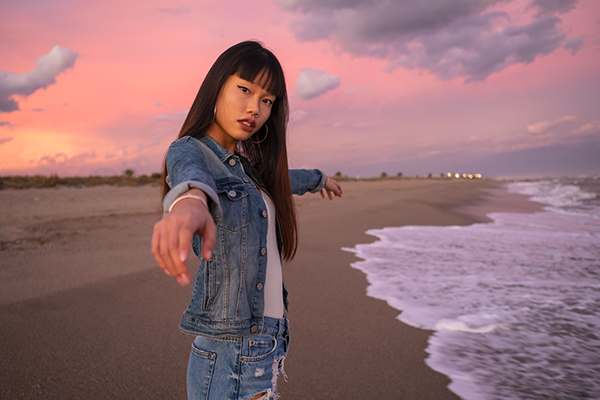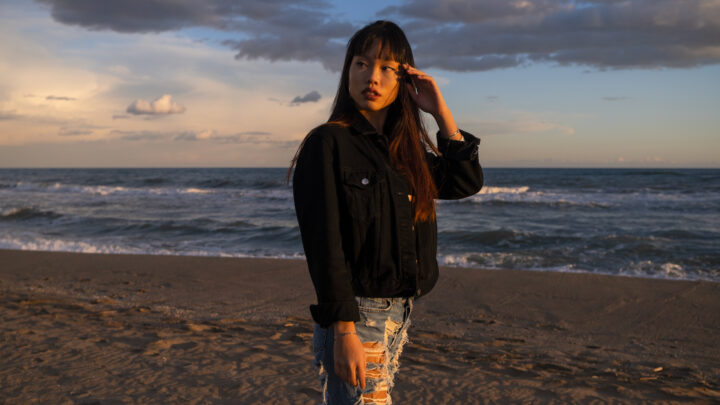In recent months I have been experimenting with wider-angle lenses, such as the Fuji 16mm f/2 and the Fuji 23mm f/2, to capture portrait images. To my surprise, I have discovered that these wide-angle lenses can help create stunning, captivating portrait images. They can provide a unique perspective and create an atmosphere that is hard to replicate with longer focal lengths.
This fact surprised me because I love to shoot portraits with the classic 85mm focal length.
I love shooting portraits with my Fuji 56mm f/1.2, an 85mm focal length equivalent to a full-frame camera sensor. The 85mm focal length lenses and their equivalent for an aps-c sensor camera are fantastic for taking portrait images with excellent bokeh without much effort.
So why am I using wide-angle lenses more and more often to take portraits differently from before?
The main reason is that portraits captured with wide-angle lenses can be so interesting because they allow you to capture more of the scene. Furthermore, through a wide-angle lens portrait, you can show a completely different perspective and unusual angles compared with what you can achieve with an 85mm or the classic 50mm focal length used to make portraiture.
As you change from an 85mm focal length to a 35mm focal length, to make an example, you completely change how you see reality in the viewfinder. It is like changing your own eyes and starting to see reality from a different perspective.

Photographers often rely on the tried-and-true lenses of the 50mm and 85mm focal lengths to capture great portraits. But if you’re looking to capture a portrait in a different way, try using a wider-angle lens. A wide-angle lens will give you a different look and can help to show the scope of the scene.
Wide-angle lenses are typically those with a focal length of 35mm and below. These lenses can be used to capture a variety of scenes, but they can also be used to create unique portraits. Wide-angle lenses can help to add context to a photo, and can be used to create an interesting depth of field. When used for portraiture, wide-angle lenses can also help to emphasize the features of the subject and create a more dynamic image.
When using a wide-angle lens for portraits, it’s important to take the time to compose the photo correctly. The subject should be the focal point, but the lens can also be used to capture the background and environment. This can help to tell a story about the person and the scene.
One of the most important things to remember when using a wide-angle lens for portraits is to avoid distortion. Wide-angle lenses can cause distortion, so it’s important to stand far enough back from the subject to avoid this issue.
Additionally, wide-angle lenses can also cause the subject to appear smaller in the frame. If you’re shooting a close-up portrait, you may want to use a longer focal length lens to avoid this issue.
Overall, wide-angle lenses can be a great way to capture portraits in a different way. With some practice, you can use a wide-angle lens to create interesting and dynamic portraits.
What is a wide-angle lens?
A wide-angle lens on full-frame sensor cameras is a 16-35mm focal length, and on a crop-sensor camera is a 12-24mm focal length.
So with a wide-angle lens, especially at its wider focal length, you can put in your image a considerable sense of depth. With a wide-angle lens, you can put so much into the frame, which is why these lenses are challenging for composition.
Seeing a scene standing in front of you is entirely different from seeing a photograph captured through a wide-angle lens.
Use wide-angle lenses to make storytelling
Taking a portrait using a wide-angle lens will capture more elements than using an 85mm focal length. Using this lens, you can enhance perspective and say more things about the subject of the portrait.
In addition, the wide view allows you to create an exciting relationship between the subject and the location. This way, you can make environmental portraits.
Using a wide-angle lens, all the elements you can include in the scene will help you make the storytelling about your subject more effective. In fact, rather than focusing only on the subject, the environmental portrait uses the background to convey an idea and says something about the photograph’s subject.
Every element on the frame goes around the subject to create an engaging atmosphere. But you must be careful because the subject could become less important in the scene as you add more elements to the frame. So you must ensure your subject is clear.
Be careful with distortion
A wide-angle lens not only enhances perspective but also creates distortion. For this reason, you should be careful while taking a portrait with this lens. For example, if you compare a portrait taken with a 24mm focal length and another taken with an 85mm focal length, you will notice that the first one will slightly distort your subject, especially around the edges of the frame.
The image distortion can make objects look bigger by placing them too close to the lens. While if you capture them further away, they will look smaller. In this way, you can also give less or more importance to an element in the composition.
Barrel distortion
On the other side, wide lenses cause barrel distortion, where lines that are straight in real life seem to curve inward. That happens because the lens view is wider than the camera’s sensor.
To avoid this problem, try to put your subject close to the center of the frame where the image distortion is less intense. In that way, you will keep the correct proportions of the body.
In the middle of the action
Wide-angle lenses put the viewer in the middle of the action. Feeling in the middle of the action dramatically impacts the photograph’s viewer and creates an immersive experience for the person looking at the image.
Use the rule of thirds
Try to compose the scene using this rule. In fact, with a wide-angle lens, you can have more elements in the frame. In this way, you can give more order to the image. The rule of thirds is probably one of the essential composition rules to catch the viewer’s attention in the photograph. It creates a guideline through all the frame elements and gives the subject more or less importance.
Depth of field, fill the frame
Wide-angle lenses have a greater depth of field than longer lenses at the same aperture, which is an excellent tool for creating an immersive experience for the viewer through the image. Try to put different elements between the lens and the subject. For example, it may be a small leaf or even a window. This way, you will make a dynamic and original picture that will capture the viewer’s attention.
With a wider lens, all you need is to create an exciting story around your subject.
